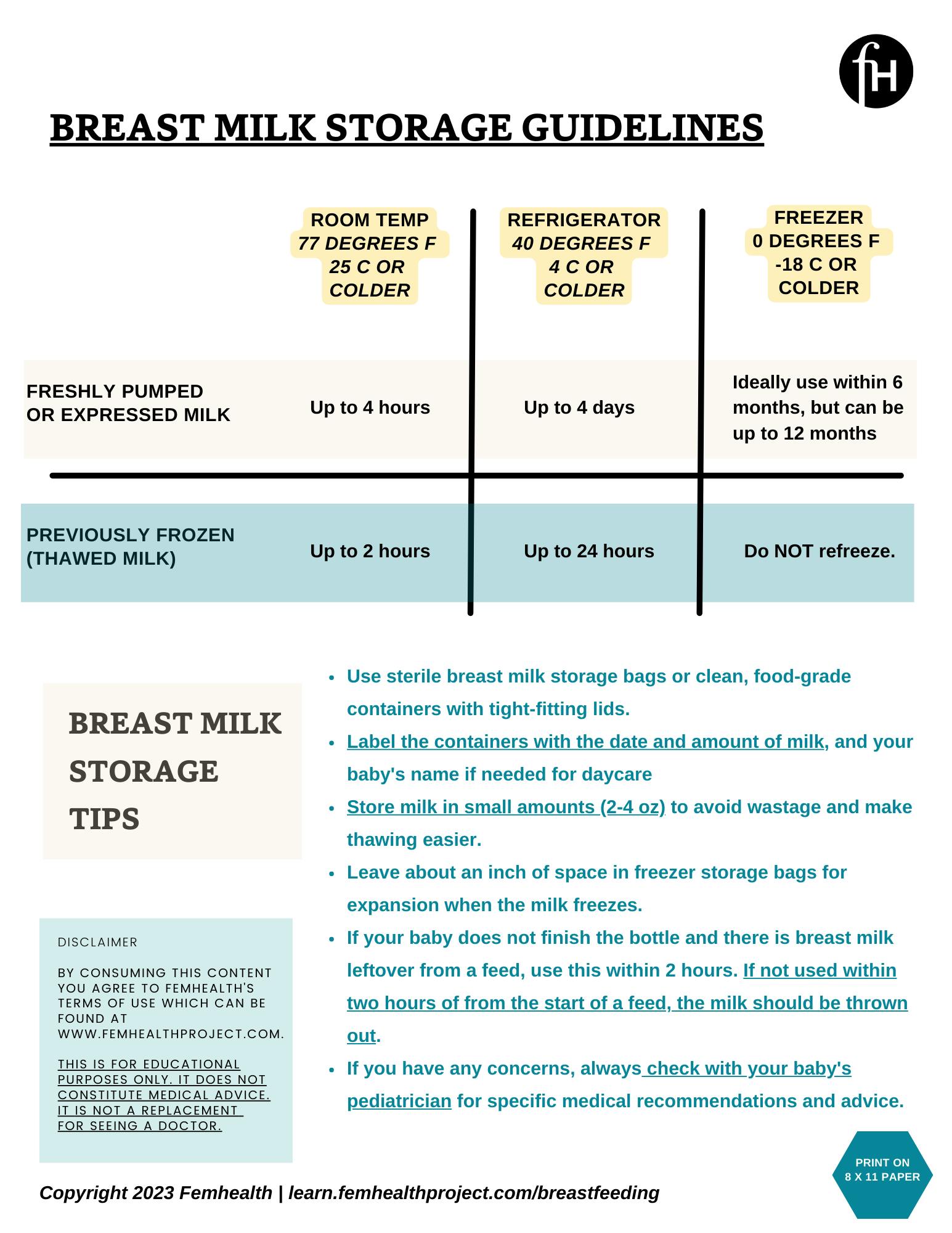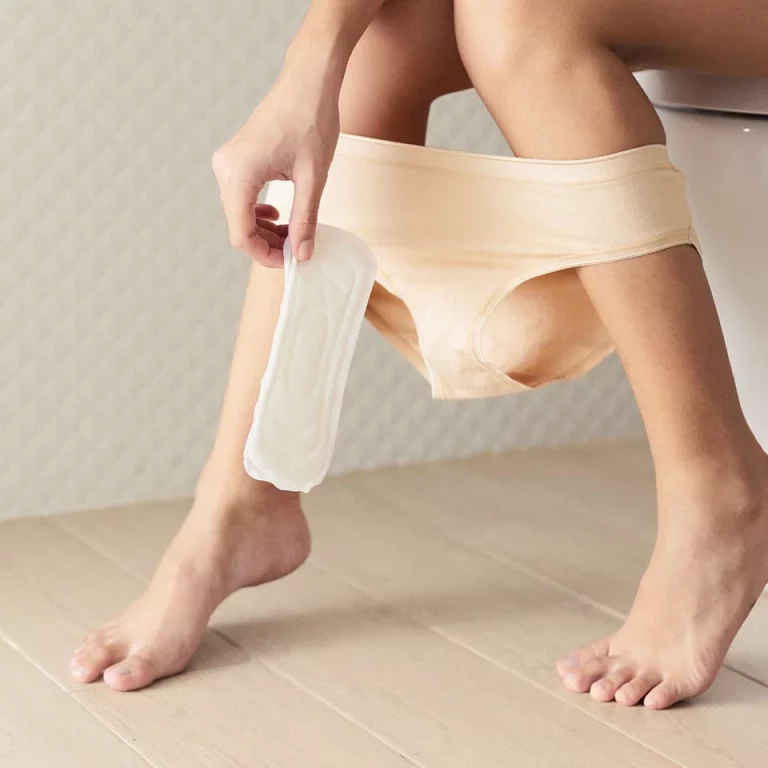Printable Breast Milk Proper Storage Guidelines
Storing breast milk properly is important for the health and well-being of infants. Proper breast milk storage preserves the human milk’s nutritional content and prevents spoilage. Many mothers find printable breast milk storage charts incredibly useful. These charts offer a convenient reference to help them adhere to proper storage guidelines. This article offers a free printable breast milk storage chart along with helpful information on how to properly store breast milk and know if or when breast milk has gone bad.
With a comprehensive storage chart, parents can easily identify the optimal storage duration and methods for breast milk at various temperatures, enabling them to maintain the highest quality milk for their babies.
Breast Milk Storage Chart & Tips Printable – Click To Download
When it comes to storing breast milk, it’s essential to know the correct storage guidelines to avoid wastage and ensure that the milk remains safe and nutritious for your baby. A breast milk storage chart printable is a helpful tool that simplifies these guidelines and can be easily referred to whenever needed.
The storage chart includes information on various storage parameters, such as room temperature, refrigerator, freezer, and thawed milk. Here are breast milk storage guidelines that you can print for yourself and for any caretakers of breastfed infants.

Click Here To Download Breast Milk Storage Chart Printable
Keep in mind that these human milk storage guidelines may vary slightly for premature infants or babies with specific medical conditions. The best way to get tailored recommendations for the health of your baby is to discuss with your pediatrician.
Besides the storage chart, it’s important to follow best practices when storing breast milk. Here are some breast milk storage tips to remember:
- Use breast milk bags or clean, food-grade milk containers with tight-fitting lids (CDC).
- Label the containers with the date and amount of milk, and your baby’s name if needed for daycare
- Store milk in small amounts to avoid wastage and make thawing easier. The best way is in 2-4 ounce increments. Frozen milk should be stored from oldest to newest, with the newest being stored in the freezer. This way the oldest milk is easiest to access. You can use frozen breast milk for 6-12 months but ideally use it within 6 months so that the nutrients are more likely to be preserved.
- Leave about an inch of space in freezer storage bags as frozen milk will expand and take up more space.
Proper Breast Milk Storage Techniques
Room Temperature
At room temperature, freshly expressed or pumped breast milk can be stored safely for up to 4 hours. Especially if the baby’s next feeding is within 4 hours, you can give them fresh breast milk rather than having to put it away in breastmilk storage bags. Just leave the expressed or pumped milk in the collection container that comes with your electric pump. Fresh milk is typically warm milk and doesn’t need to be heated before giving to your baby.
Refrigerator
When storing breast milk in a refrigerator, keep it at a temperature of 4°C (40°F) or cooler. It can be stored in the fridge for up to 4 days, although it is optimal to use or freeze the milk within 3 days (Mayo Clinic). Store the milk in the back of the refrigerator to avoid temperature fluctuations in the front or on the door.
Freezer
Breast milk can be stored in a standard freezer at a temperature of -18°C (0°F) or colder. In these conditions, the milk can be safely frozen for up to 6 months. However, it’s best to use the milk within this timeframe for optimal nutrient content (CDC Guidelines).
Deep Freezer
For longer storage, a deep freezer set at -20°C (-4°F) or colder can be utilized. In this case, freshly expressed breast milk can be stored for up to 12 months. However, it is still best to use the milk within 6 months to preserve its nutritional value (CDC Guidelines).
Thawing and Warming
To thaw frozen breast milk, place it in the refrigerator overnight or under cool running water until thawed. Avoid using a microwave or placing the milk in boiling water, as this can create hot spots and destroy nutrients. Once thawed, the milk can be gently warmed in a container of warm water, and it should be consumed within 24 hours (Medela).
Power Outages
Related: Postpartum Rib Pain
In the case of a power outage, begin to think of a back up plan for what you may be able to do to preserve your breast milk stash. The last thing you want is for all your milk supply to be wasted during the period of time when you may not have power. The first step is do not open the freezer. The more you open and close the freezer and allow warm air in, the faster your liquid gold will thaw. In most cases, power will come back in a few hours and if the freezer is cold enough and has not been opened, it is unlikely that your milk unfreezes.
If its been over an hour, call a friend and see if they have power or a way to store your milk. You can also purchase ice from a local gas station and put it in a cooler as well. Finally, check online to see when the power will be returning so you know how much time you have before your freezer stash begins to thaw. Depending on how much milk you have to store, you will need to plan accordingly.
Factors Affecting Milk Quality
Storage Duration
Freshly expressed breast milk can be stored safely for varying times depending on the storage conditions. It is generally safe to store breast milk in the back of the refrigerator for up to four days, but it is optimal to use or freeze the milk within three days. In a deep freezer, breast milk can last up to 12 months; however, using it within six months is preferable for maintaining optimal nutrition content, especially vitamin C (Mayo Clinic).
Storage Containers
It is important to use appropriate storage containers for preserving the quality of breast milk. Containers specifically designed for breast milk storage should be used. These include glass or BPA-free plastic containers with tight-fitting lids, as well as breast milk storage bags. Avoid harmful substances like bisphenol A (BPA) in plastic containers and storing milk in disposable bottle liners or regular plastic bags as they can easily leak It is essential to place the breast milk in a clean, food-grade container with a tightly fitting lid. Avoid containers made of BPA-containing plastics, usually marked with the recycle symbol number 7 (CDC).
Handling and Labeling
Proper handling and labeling of breast milk contribute to maintaining its quality. Ensure cleanliness while expressing and storing milk. Wash hands before handling, and use clean containers and breast pump parts. Label the containers with the date the milk was expressed to track its freshness (CDC).
Thawing and heating breast milk appropriately helps preserve its nutrients. Avoid microwaving breast milk, as this may destroy nutrients, create hot spots, and lead to uneven heating that can burn the baby’s mouth. Instead, thaw milk using lukewarm running water, or by placing it in a container of lukewarm water or in the refrigerator overnight (CDC).
Safety Tips And Guidelines
How To Tell If Breast Milk Has Gone Bad
It’s essential to know when stored breast milk has gone bad. Some indications of spoiled breast milk include a sour smell or taste, separation of fat that does not combine when shaken, and clumps or chunks in the milk. When giving previously frozen milk, use the oldest milk first. If your baby rejects the milk or refuses to drink it, this could be a sign of excess lipase or that the milk tastes bad. Always inspect and smell the milk before feeding your baby to ensure its freshness.
Hygiene
Maintaining proper hygiene is crucial while handling breast milk. Ensure that you wash your hands before expressing or handling breast milk. Always use clean, food-grade containers made of glass or plastic with tight-fitting lids for storage. Avoid plastic containers with the recycle symbol number 7, as they may contain BPA (CDC). Sterilize the breast pump and storage containers regularly to prevent contamination.
Discarding Unused Milk
It’s important to discard unused breast milk if it has been left at room temperature for more than 6 hours or if the baby has not finished a feeding within 2 hours of starting. Additionally, breast milk thawed in the refrigerator should be discarded after 24 hours and should not be refrozen.
Transporting Stored Breast Milk
When transporting stored breast milk, use an insulated cooler with ice packs to maintain the appropriate temperature. At room temperature, freshly expressed breast milk can be safely stored for up to 6 hours, but it’s optimal to use or transfer it to proper storage within 4 hours, especially in warm environments. In a refrigerator, breast milk can be stored for up to 3 days, and for up to 6 months in a freezer (CDC).
Proper Breast Milk Storage Guidelines: Summary
Being a new parent can be overwhelming. Breastmilk storage guidelines are important to know but hard to remember. Breast milk storage charts provide information on important aspects, such as ideal storage containers, the maximum time for which milk can be stored, and the recommended ways to thaw and warm frozen or refrigerated milk. This information is crucial for maintaining the milk’s safety and efficacy, as improper handling can lead to the loss of valuable nutrients or the growth of harmful bacteria. By following the guidelines presented on a printable breast milk storage chart, parents can ensure they are providing their babies with the best possible nutrition from expressed milk.
Printing the above chart can help you have one less thing to remember. In addition, the Academy Of Breastfeeding Medicine and the CDC both provide human milk storage information as can your doctor. Breast milk whether it is fresh breast milk or breast milk that has been frozen, is a great way to provide your baby with nutrients and disease fighting antibodies. Storing it properly is important for the health of your child.
We discuss products we think are useful to people. If you buy something through our links, we may earn a commission. Remember to check with your personal physician to see if a product recommended is right for you.








